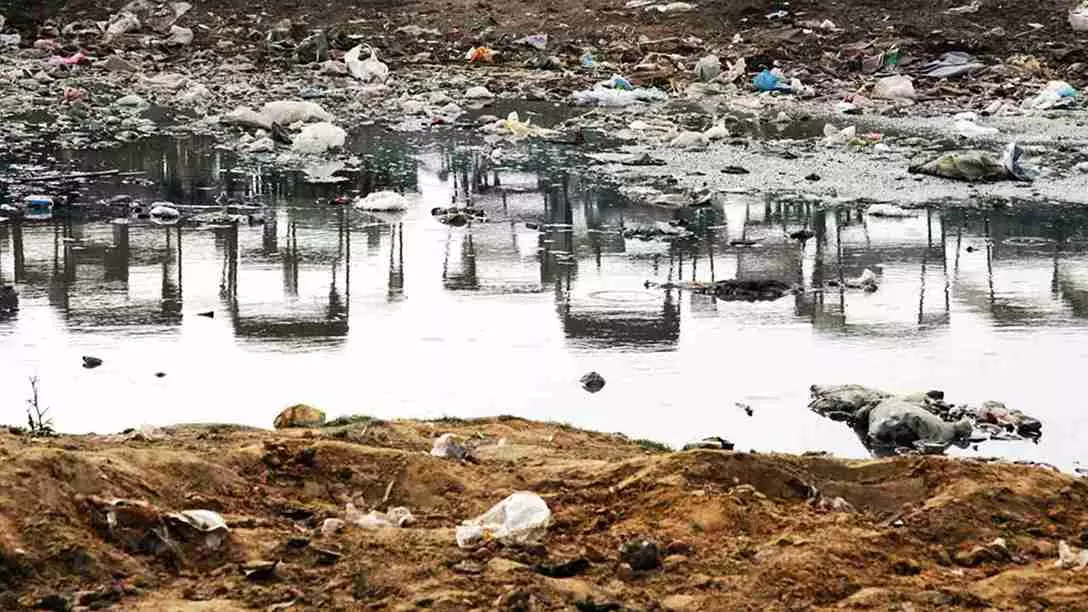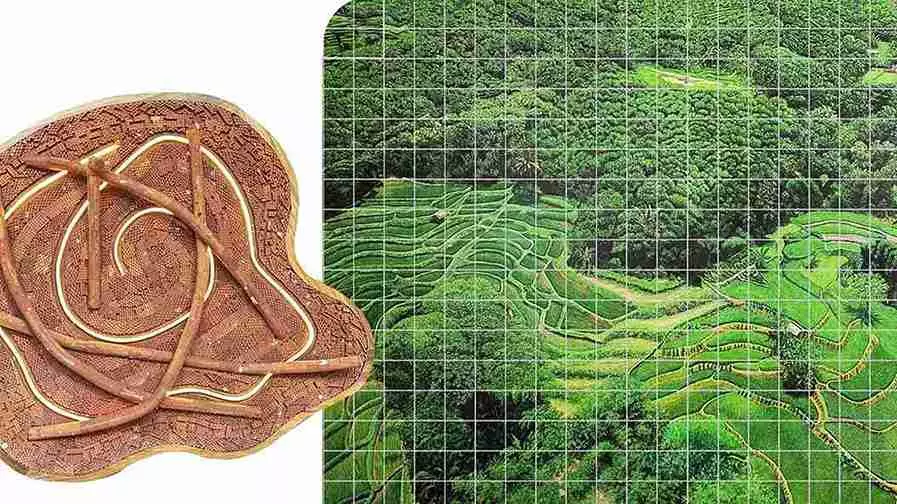
- Home
- India
- World
- Premium
- THE FEDERAL SPECIAL
- Analysis
- States
- Perspective
- Videos
- Sports
- Education
- Entertainment
- Elections
- Features
- Health
- Business
- Series
- In memoriam: Sheikh Mujibur Rahman
- Bishnoi's Men
- NEET TANGLE
- Economy Series
- Earth Day
- Kashmir’s Frozen Turbulence
- India@75
- The legend of Ramjanmabhoomi
- Liberalisation@30
- How to tame a dragon
- Celebrating biodiversity
- Farm Matters
- 50 days of solitude
- Bringing Migrants Home
- Budget 2020
- Jharkhand Votes
- The Federal Investigates
- The Federal Impact
- Vanishing Sand
- Gandhi @ 150
- Andhra Today
- Field report
- Operation Gulmarg
- Pandemic @1 Mn in India
- The Federal Year-End
- The Zero Year
- Science
- Brand studio
- Newsletter
- Elections 2024
- Events
Art for earth: How contemporary Indian artists draw on ecological crisis

In one of the works by Kolkata-born artists M. Pravat, whose solo exhibition, Terraform, opens at STIRGallery in Delhi on January 18 and will be on till January 25, a sculptural swirl of earthy tones twists and turns on the left, like a whisper preserved in bronze. It is a map, perhaps, of unseen currents — lines etched with care yet imbued with chaos, mimicking roots that search and...
In one of the works by Kolkata-born artists M. Pravat, whose solo exhibition, Terraform, opens at STIRGallery in Delhi on January 18 and will be on till January 25, a sculptural swirl of earthy tones twists and turns on the left, like a whisper preserved in bronze. It is a map, perhaps, of unseen currents — lines etched with care yet imbued with chaos, mimicking roots that search and tangle beneath the surface. The jagged rods puncture through the terrain, breaking and bridging space, as if daring the viewer to trace the story of the land in their palm.
On the right, a verdant mosaic stretches infinitely, of terraced fields that hum with life. The land cascades downward in perfect rhythm, every square portraying the deliberate carving of the earth into something fertile and alive. The grids capture the pulse of green — order imposed on wilderness — but they also hold the profusion of sprawling growth. Together, the two halves form a dialogue: the sculpture speaks of both design and disruption, of toil and abundance. A conversation, eternal and unresolved, between urban environments and the natural world.
Using an eclectic mix of materials — bricks, stone, pigment, dust, paintings, LED lights, and found objects — Pravat’s sculptures and installations evoke modern cityscapes, a milieu perpetually under construction, reflecting the destructive nature of human intervention in the environment. Probing the tensions between our built spaces and nature’s fragility, Terraform calls for a recalibration of sensibilities toward sustainability. Pravat is among a cohort of environmentally conscious Indian artists who are reshaping narratives around ecology through their innovative practices.
Delhi photographer-artist Ravi Agarwal’s multidisciplinary works similarly demand we reconsider the natural world, particularly rivers, as sentient beings. His project, Else All Will Be Still is a visceral chronicle of degradation that connects photography, video, and participatory art to allow the viewer to experience rivers like the Yamuna as ecosystems. Scarred by industrial waste yet vital to millions, the river becomes a carrier of human histories and aspirations. Agarwal highlights the pressing need for an urgent dialogue about water bodies, where the viewer is no longer a passive observer but an active participant in ecological healing. As the founder of the environmental NGO Toxics Link, he has been instrumental in addressing hazardous waste issues and advocating for sustainable waste management in India.

In Else All Will Be Still, Ravi Agarwal highlights the pressing need for an urgent dialogue about water bodies, where the viewer is no longer a passive observer but an active participant in ecological healing.
Atul Bhalla’s Yamuna Walk, on the other hand, brings water into sharp focus as a metaphor for survival, pollution, and hope, blending personal observation with public discourse. Bhalla’s meditative journeys along Delhi’s Yamuna River engages viewers in the paradoxes of purity and contamination; Bhalla underlines water’s spiritual and ecological dimensions. His photographic documentation can be seen as an experiential dialogue. The artist duo Jiten Thukral and Sumir Tagra, popularly known as Thukral & Tagra, bring a different energy, transforming climate change and agrarian crises into sensory experiences through immersive, witty installations. Through gamified installations and participatory setups, they balance playfulness with poignant reflection on consumption, aspiration, and sustainability.

Atul Bhalla’s Yamuna Walk brings water into sharp focus as a metaphor for survival, pollution, and hope, blending personal observation with public discourse.
Gigi Scaria’s urban-centric installations critique the unsustainable development practices reshaping Indian cities. His work ‘Elevator from the Subcontinent’ combines architectural models and video projections to highlight the socio-environmental inequities arising from rapid urbanisation. Scaria’s art underscores the urgency of adopting sustainable urban planning frameworks to mitigate ecological harm.
Similarly, Manjunath Kamath’s practice is rooted in the art of storytelling. He often uses found and discarded objects for his works that critique consumer culture. In his installations, Kamath resurrects materials deemed useless, transforming them into visual commentaries on waste and sustainability. His works not only highlight the environmental consequences of rampant consumerism but also celebrate the potential of reuse and upcycling. By reimagining waste as art, Kamath challenges the notion of obsolescence. His pieces encourage audiences to rethink their own consumption patterns, making his art as much about introspection as it is about aesthetics.
Vibha Galhotra’s monumental sculptures and installations often throw into sharp relief urbanisation and environmental decay. Her series on Yamuna uses ghungroos (ankle bells) to create large-scale installations that evoke the river’s lost vitality. While primarily known for his abstract and monumental sculptures, Anish Kapoor’s recent explorations into sustainable materials also signal a growing environmental consciousness. Kapoor’s experiments with Vantablack — a material that absorbs 99.96% of light — have sparked discussions about the interplay between visibility, perception, and our blind spots toward environmental crises.
Sheba Chhachhi’s multimedia installations reveal the intersectionality of gender and ecology, as seen in The Water Diviner, where water scarcity is framed as a deeply feminist issue, embodying the politics of care and community. Intertwining oral histories, archival materials, and site-specific interventions, Chhachhi reclaims forgotten narratives, positioning women as central figures in the fight against environmental degradation. Her work becomes a site of resistance, challenging patriarchal structures that marginalise women’s voices in ecological debates. Through her installations, Chhachhi suggests community-driven solutions in addressing environmental challenges.
Bengaluru-born Shilo Shiv Suleman’s works showcase the intersection of technology, spirituality, and environmentalism. Her project ‘Pulse and Bloom’ features interactive installations powered by participants’ heartbeats, symbolising the symbiotic relationship between humans and the Earth. Through her initiative, the Fearless Collective, Suleman also addresses environmental justice, creating murals that amplify marginalised voices and advocate for sustainable living.
Sunoj D, a Kerala-based artist, has an ongoing project, The Table’s Edge. It involves cultivating a piece of land as an artistic practice; it’s an exploration into sustenance, labour, and ecological balance. By engaging with the soil directly, Sunoj draws our attention to industrial farming practices while celebrating the traditional agricultural knowledge.

M. Pravat’s Terraform urges us to reconsider our relationship with the built and natural worlds.
These artists, through fearless integration of material and memory, have created a visual language of resistance that envisions alternate futures. M. Pravat’s Terraform is in this continuum, urging us to reconsider our relationship with the built and natural worlds. By transforming their canvases and installations into arenas of ecological thought, these artists compel us to imagine a world where creativity and conservation go hand in hand, shaping a sustainable and equitable future.
